Before moving forward into the new year, I wanted to take once last glance backward to 2023 in regards to food that has been modified genetically. There were three big announcements in 2023 that involved genetically changed / altered / modified food and food sources that have been modified by CRISPR breeding technologies.
If you’re not familiar with the acronym, CRISPR (Clustered Regularly Interspaced Short Palindromic Repeats) is essentially a DNA gene-editing system. It allows scientists to edit parts of the genome by removing, adding, or altering sections of DNA in order to dial down undesired traits and dial-up/in to traits that are beneficial.
In recent years, GMOs (Genetically Modified Organisms) have entered the market. In 2020, GMO soybeans made up 94% of all soybeans planted, GMO cotton made up 96% of all cotton planted, and 92% of corn planted was GMO corn.1 (In fact, I learned this year—along with my 6th and 8th graders—that GMO cottonseed oil (in addition to feeding cattle) is commonly used in crackers, peanut butter, tortillas, chips, baked goods, fruit snacks, and as a frying oil in mainstream restaurants2.)
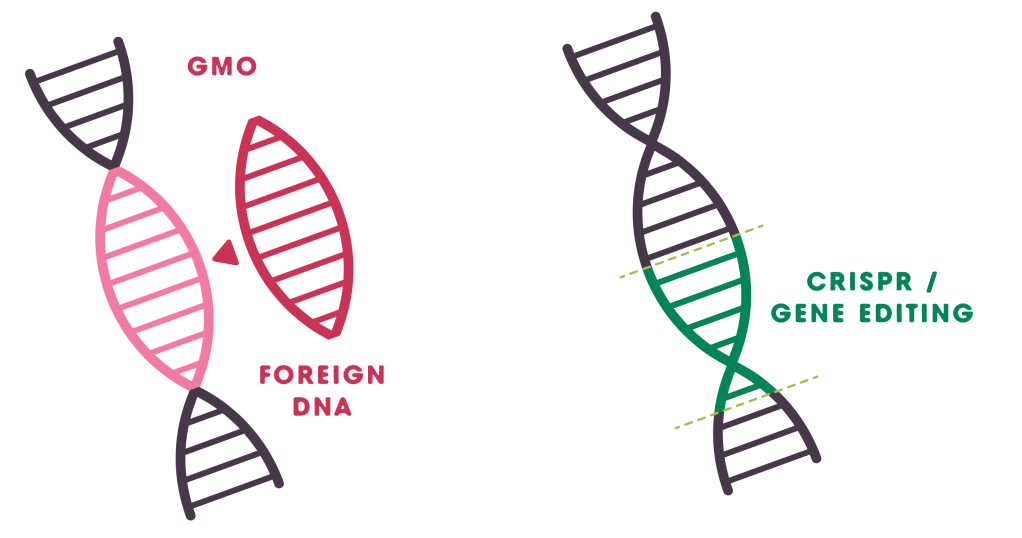
Keep in mind that there is a difference between GMO and CRISPR genetic editing processes. GMO takes two organisms/kinds that do not naturally reproduce in nature and joins their DNA thru gene editing. CRISPR gene editing removes or add genes into the genome within the plant’s own kind. As you read on, keep these methodologies in mind.
These bio-engineered improvements are touted as “improved”. Yet, there is little research to be found online on the genetic effects of bio-engineered foods on the human body on a cellular level — specifically whether or not they cause inflammation in the human body. If the altered foods have polyphenols and antioxidants, how can it be measured how these foods had a positive (or otherwise) impact on the human body?
Genetically engineered crops must be approved by the U.S. Department of Agriculture (USDA) before they can be freely grown and consumed in the United States. I was not able to find if the USDA runs any sort of trial or tests of bio-engineered products on actual human beings before allowing them to enter the marketplace. From what I can gather, it appears that the USDA focus on any concerns they have is to the plant affecting other plants or insects and animals from an environmental perspective (which needs to be looked at) more so than understanding how these changes within the DNA code will affect the human body. If there is concern by the USDA, it is not readily transparent with receipts to show its safety claims on humans. (I do not claim to be an expert is this area and only have common knowledge on the subject. I would be happy to learn more from someone in the genetic field about what happens behind the scenes that the general public may not see.)
Without further delay, let’s dive in and explore what is coming (or has arrived in 2023) in a grocery store near you. Remember, this is for informational purposes only so readers can make informed decisions.
28-DAY NON-BROWNING APPLES
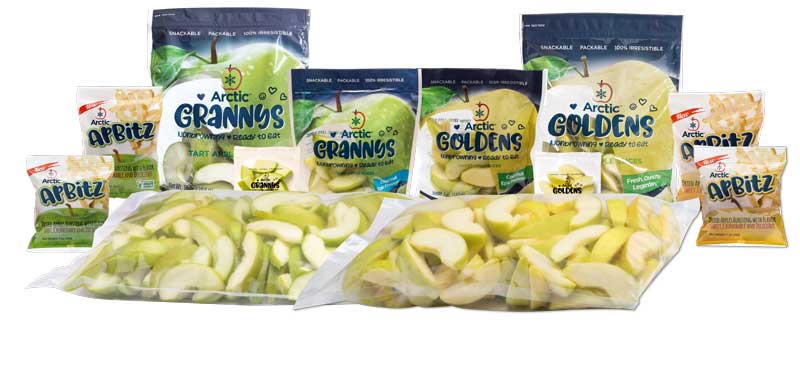
In October of 2023, The Packer, an industry trade publication for producers and grocery stores, shared that Okanagan Specialty Fruits had received approval for taking non-browning, “Arctic” apples to the public. In turning off the enzyme that makes the apple turn brown, the Arctic apple is said to stay “orchard fresh” for up to 28 days.3
It reported that Okanagan Speciality Fruits (parent company Third Security, LLC formally known as Intrexon4)5 was building a 110,000-square-foot processing facility in Moses Lake, Washington.6 This processing facility has been touted as being able to process more than 50 million pounds of apples per year. When fully built (anticipated 2024), it will be able to store, process and pack more than 100,000 bins of Arctic apples.
Okanagan Specialty Fruits picked their first Arctic apple in 2004.7 Currently, Okanagan Specialty Fruits has 1,250 acres of Arctic Fuji, Arctic Golden, and Arctic Granny apples. Arctic Gala will be the next variety the company will grow followed by Arctic Honey and Arctic Pink.8 When you see the Arctic brand, know that this fruit has been genetically modified to not brown as quick as other apples.
Some questions I have for Arctic and the USDA….
• If you can’t see an apple brown, and it doesn’t brown for 28-days how do you know if pre-cut apples on the store shelf are still fresh to eat?
• Has the DNA change affected the nutritional profile of the apple? If so, what was lost/gained?
• Has the DNA change been tested in how it will affect the human body?
• In removing this browning enzyme, will it alter how the human body utilizes the nutrients?
• Will it cause inflammation in the body?
• Studies have shown that there is nutrient loss from the time of harvest in many foods. What happens to the nutritional profile of the apple from time of harvest to table?

MOVE OVER ROMAINE … CRISPRED PURPLE MUSTARD GREENS ARE NOW MORE NUTRITIOUS
Conscious Greens, a product of Pairwise Conscious Foods, is offering purple leafy greens that boast double the nutrition of romaine.9 They set out to improve upon lettuce’s nutritional profile and used CRISPR breeding technology by taking mustard green DNA and editing the DNA to dial down any bitter flavor. It is said to now taste like romaine or any other green in a salad mix.
The company is also currently working on seedless blackberries, black raspberries, and red raspberries, as well as pit-less cherries, all with year-round availability under its Conscious Foods brand.10
Some questions I have for Conscious Greens (aka: Pairwise) and the USDA….
I’m wondering how these claims really play out in the human body. Where are the studies? I would like to learn more. I know that flavonoids play an important role in the body while also offering flavor (these are released when you cut into an herb for example). Have these anti-oxidants been deleted or altered? I’d love to learn more about your process there and see some transparency. If the flavor has been dialed down, how did you preserve the nutritional benefit?
A reminder to we, the consumer.… As for those of us growing our own food for health and Pairwise’s plans… CRISPR changes aside, remember, a plant without a seed cannot reproduce in kind and you must go back to the source that makes the original seedless plant to continue enjoying the fruits (unless somehow propagated — which would be against the law because said plant would be trademarked/copyrighted.) Food freedom can only exist if the plant can reproduced as God intended — by seed or natural propagation. I’m leery of anyone removing that option from my food source.
Also, I also find it super interesting that Bayer and Pairwise have formed “a strategic alliance to advance agriculture research and development through gene-editing technology.” Within this partnership, Pairwise says it works in corn, soybeans, wheat, cotton and canola crops exclusively with Bayer. Together, they created a new corn phenotype that produces 20% more kernels on a corn thereby increasing corn production.11
I also noticed that Pairwise recently got a pass on changes made to brown mustard. I use brown mustard to make my homemade mayonnaise. Will it be disclosed by these dijon mustard companies that their brown mustard seed is altered because it didn’t have to go through the approval process by the USDA? And again, does this alteration to the DNA affect just the plant growth mechanism, or has any nutrient been altered as well?
ANTIOXIDANT-RICH GMO PURPLE SNAPDRAGON TOMATOES
In July, Norfolk Plant Sciences says it successfully completed a consultation with the FDA12 regarding its high-antioxidant, genetically engineered purple tomato.13 14 15According to their Web site, they carefully added two genes from snapdragons that work like “on switches.” As they explain, “These ‘on switches’ turn on the antioxidant benefits already in the purple tomato skin and juice DNA.” Y’all, this tomato is the darkest purple I’ve ever seen (albeit I’m looking at examples by photo / screen) —it’s even darker than Indigo Chocolate or Black Beauty by the looks of it.
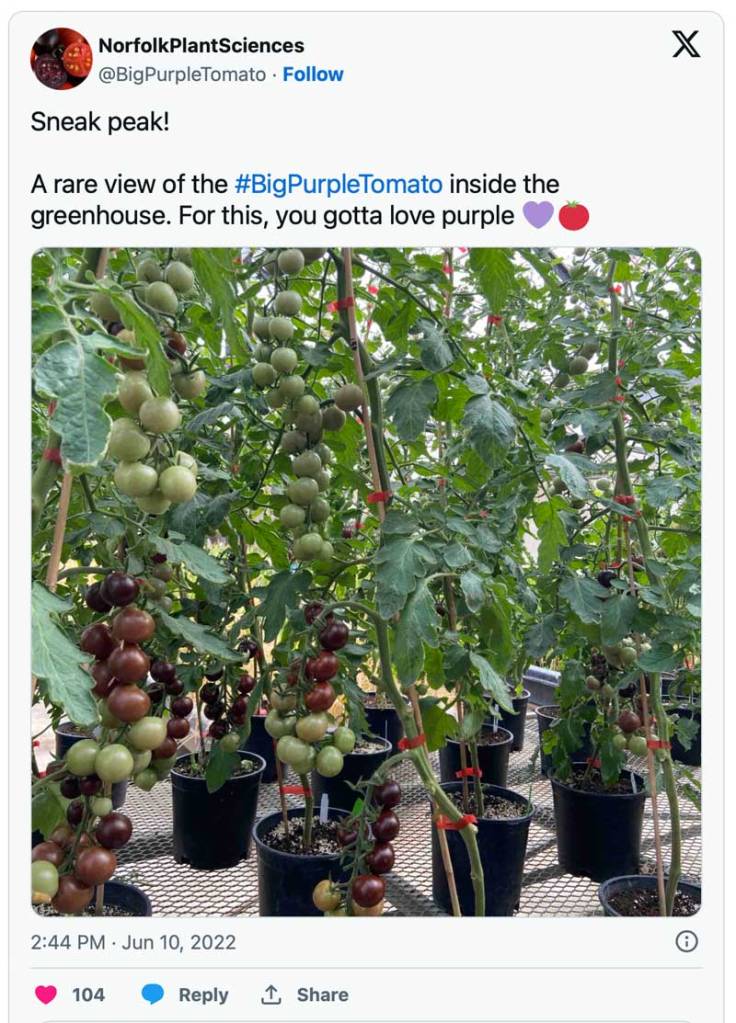
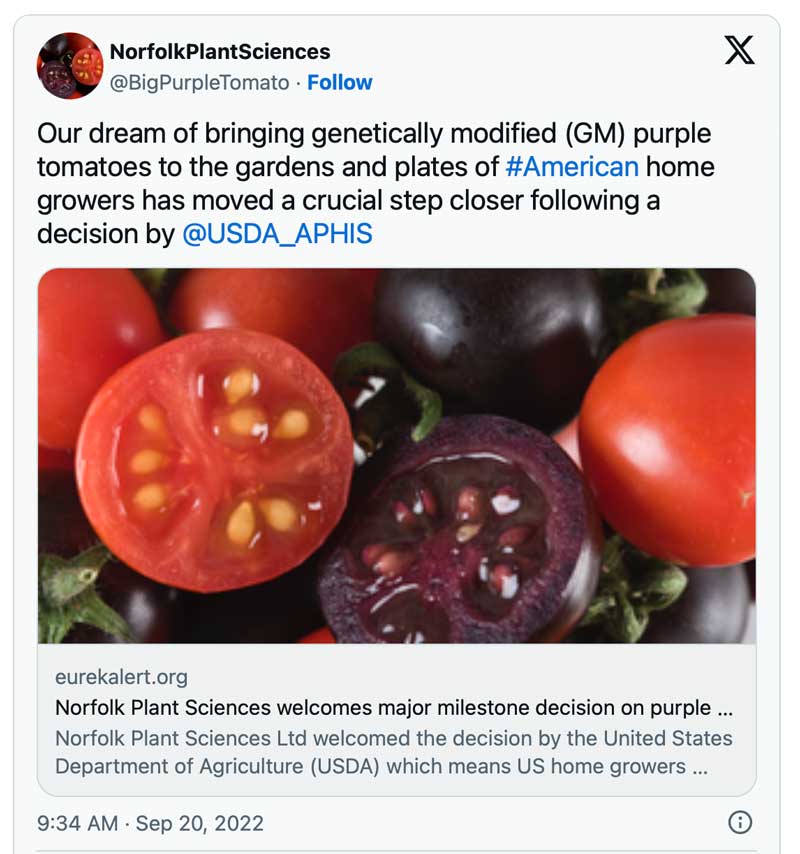
Purple tomatoes have been shown through research to be higher in anthocyanins and polyphenols — anti-oxidants that have health benefits similar to eating blueberries or blackberries.
The company states, “We have developed a proprietary technology for massively enhancing the production of beneficial phytonutrients in plants. Tomato fruit expressing two genes derived from another plant species, antirrhinum (the edible snapdragon flower), are a beautiful deep purple colour. These tomatoes contain high levels of anthocyanins, the healthy polyphenols associated with consumption of blueberries, blackcurrants acai, and pomegranate. A paper published in Nature Biotechnology in 2008 showed that consumption of NPS purple tomatoes extends the lifespan of cancer-prone mice by 30%.”16
Some questions I have for Norfolk Plant Sciences (aka: Big Purple Tomato / Little Purple Tomato) and the USDA….
I’m curious to see any lab work on the nutrient profile of this tomato compared to other tomatoes bred through natural methods. Again, I’m not against the claimed benefits — we want to focus on foods that heal our body. Just wondering what other research is saying about these altered tomatoes. Forgive my skepticism, as the tomatoes I find in the grocery store have been modified genetically (aka “bio-engineered”) to lengthen the time from harvest-to-table and altered so they can sit on the shelf and not decay. They tomatoes are absolutely tasteless in my opinion. These GMO tomatoes are the reason why I love to grow Cherokee Purple Tomato or Black Cherry Tomatoes every season and look forward to when they produce. Taste and nutrition is a big part in why I like to grow my own past tomatoes — especially orange ones as they are chock full of beneficial nutrients that have been found that they help our DNA function properly and actually have been shown to bring protective qualities in regards to humans when x-rays are administered. I’d love to learn more about these genetically modified tomatoes especially since they have stated plans of introducing seeds into the everyday gardener’s plot.
BEFORE WE WRAP UP…
Before I wrap up this 2023 highlight list, I think it’s also good to be aware of what DIDN’T go through regulation. That can be cause for even more attention because we have even less information on what these companies are doing/ have done.
I’m particularly interested in the Tropic Biosciences non-browning banana because I purchased some bananas from Costco this year that NEVER finished ripening and I had to throw them out because it was just not natural. Were they just picked too green for market or was there some other DNA funny-business going on that wasn’t disclosed to the consumer. We need to be able to make informed decisions and you, the consumer should know if what you’re putting in your body has been altered at a genetic level in a lab somewhere prior to growing.
12 PLANTS GENETICALLY MODIFIED AND DEEMED NOT SUBJECT TO REGULATION
On November 14, 2023, the U.S. Department of Agriculture’s (USDA) Animal and Plant Health Inspection Service (APHIS) reviewed 12 plants modified using genetic alteration to determine whether they posed an increased plant pest risk as relative to non-modified comparators:
- Bayer Crop Science, modified soybean for herbicide resistance (glufosinate, dicamba, dichlorophenoxyacetic acid (2,4-D), and mesotrione).
- Bioheuris, Inc., modified soybean for herbicide resistance (auxin and 2,4-D)
- CoverCress, Inc., modified pennycress for reduced levels of erucic acid and reduced fiber in the seed.
- Inari Agriculture, Inc., modified corn for altered plant architecture
- Insignum AgTech, modified corn to induce a rapid response to fungal infection.
- Mazen Animal Health, Inc., modified corn for altered enzyme levels and herbicide resistance (glufosinate).
- Pairwise Plants Services, Inc., modified brown mustard for altered pungency to improve flavor and altered outgrowth/texture to reduce appendage development on leaves and stems.
- Tropic Biosciences, modified banana for altered fruit quality, non-browning.
- Yield10 Bioscience, Inc., modified four camelina plants for herbicide resistance; one for resistance to glufosinate; and three for resistance to glufosinate, imidazolinone and sulfonylurea.
APHIS found, “these modified plants are unlikely to pose an increased plant pest risk compared to other cultivated plants. As a result, they are not subject to regulation under 7 CFR part 340. From a plant pest risk perspective, these modified plants may be safely grown and bred in the United States.”
From what I can gather, these USDA decisions—based on the new regulations—focus regulatory oversight on organisms that pose a risk to plant health, but say nothing to any oversight on organisms that pose a risk to the human body, nor any information released publicly on how it would be absorbed (or not) in a human’s intestinal tract or how the DNA would interact at a cellular level within the human body once ingested.
You can find the full list of plants deemed by the USDA as not subject to bio-engineering regulation here: https://www.aphis.usda.gov/aphis/ourfocus/biotechnology/regulatory-processes/confirmations/moa/moa-table
GMO CORN GETS DEREGULATED
At the end of November 2023, the USDA announced it was deregulating Pioneer Hi-Bred International, Inc.’s (Pioneer) DP23211 corn. This corn was developed using genetic engineering to resist corn rootworm and given the genetic traits to tolerate glufosinate herbicides.17
GMO FOOD CROPS AS OF 12.30.23
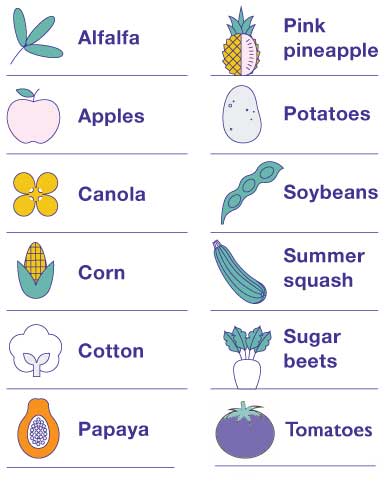
Is your head swirling yet? No fear—you can keep up-to-date on the latest list of bio-engineered foods? Click here: https://www.ams.usda.gov/rules-regulations/be
MORE INFO ON BIO-ENGINEERED FOODS:
- Alfalfa (pdf)
- Apple (ArcticTM varieties) (pdf)
- Canola (pdf)
- Corn (pdf)
- Cotton (pdf)
- Eggplant (BARI Bt Begun varieties) (pdf)
- Papaya (ringspot virus-resistant varieties) (pdf)
- Pineapple (pink flesh varieties) (pdf)
- Potato (pdf)
- Salmon (AquAdvantage®) (pdf) + more info here
- Soybean (pdf)
- Squash (summer, coat protein-mediated virus-resistant varieties) (pdf)
- Sugarbeet (pdf)
- Sugarcane (Bt insect-resistant varieties) (pdf)
- Walnuts
Look for these labels on foods that contain bio-engineered foods:

Click image below to read details:
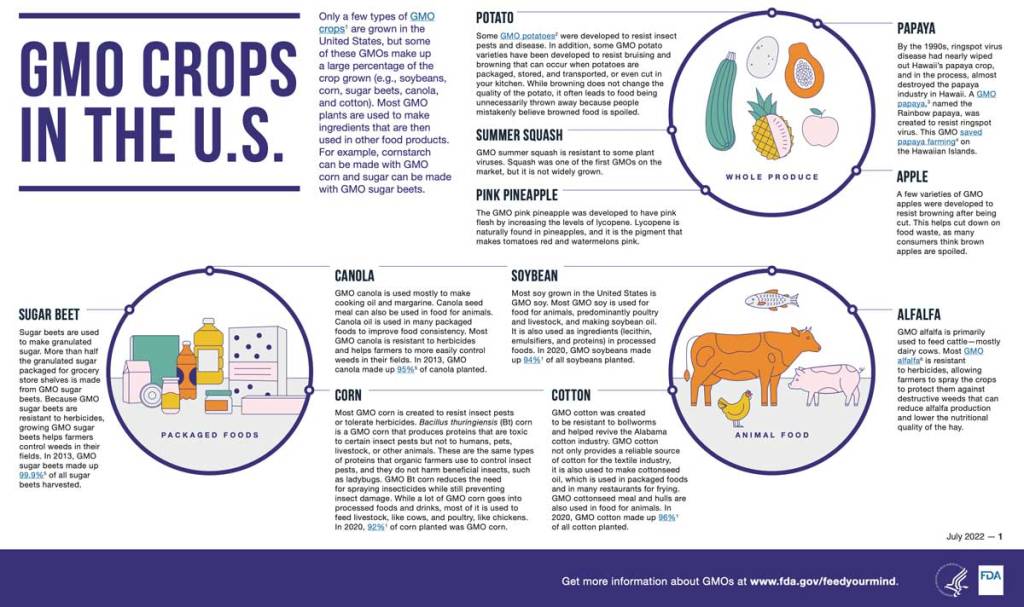
This is obviously a massive topic that keeps on growing and to try and tackle it in one article is a bit daunting. (If you’re still reading, I applaud you on caring about this area of our food supply chain.) I will circle back and provide more information as I learn more. In the meantime, please do your own due diligence and be aware of the products that have been altered genetically and reach out to these companies and feel free to ask questions of them and the USDA. And, as always, if you learn of anything not mentioned in this article, feel free to share in the comments below.
Please Note:
For both GMO and CRISPR processes, we could not find information from any of the regulatory agencies like the USDA on whether or not these genetic modification and changes have been tested in regards to how they affect the human body. If you know of any human studies that have been conducted on these genome-edited foods, please feel free to reach out to us. All research has been gleaned from online articles provided by the companies. Footnotes are noted below. We cannot be responsible for any companies changing information after the date of this posting.
We share the above information for informational purposes only and to help the public become more aware of what bio-engineered foods are entering the main stream grocery stores, restaurants, and even farmers markets in some cases. I have included sources for my research in the footnotes below and you are welcome and encouraged to dive deeper. As a sovereign human being, you have the right to be informed when making decisions about your health. We are not medical professionals, nor do we offer any medical advice. Readers are encouraged to do their own research before making any decisions on their health and you alone are responsible for what you eat or drink.
If you work in the industry or have personal knowledge or information regarding a possible violation of the USDA National Bioengineered Food Disclosure Standard (BE Standard) you may file a written statement or complaint. You can find the contact form here. https://www.ams.usda.gov/rules-regulations/be/file-complaint
NATIONAL BIOENGINEERED FOOD DISCLOSURE STANDARD LAW
Let’s remember that synonyms for “modified” also include, “altered, qualified, restricted.” The term, “modified” can sound so benign when in fact, the act of changing the DNA code at a cellular level for a given organism is essentially “man trying to be like God” as some scientist believe these foods have been designed by our Creator to nourish and even heal within our human bodies. I do believe we are created in our Creator’s image, so it is not surprising to see His creation mimicking Him, but I am not convinced yet that it is a good thing to be manipulating what He keeps in motion. I’m continuing to think about this topic in great details and hope this information above helps you to be a little more aware of what is entering our grocery stores and ultimately, our bodies.
Be well, my friends, and wishing you a wonderful and healthy New Year!
Erin

FOOTNOTES:
